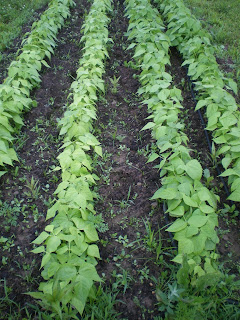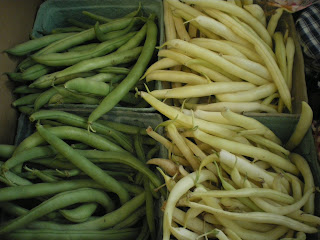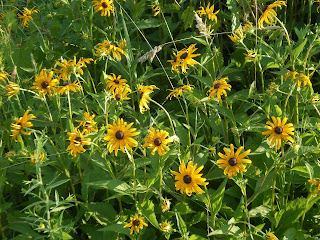After patiently waiting for the weather to cool and patiently waiting for the ripening bloom, we have finally been rewarded with red peppers that previously we could only dream about.
The largest of the red bells harvested this year are only slightly smaller than the Sugar Pie pumpkins we also brought in. These peppers are almost too big to stuff however may be fine if cut in half and made into two servings rather than just one.
As an experiment, we also had planted butternut squash and nestegg gourds. The squash is finally starting to ripen. These will be excellent in creamed squash soup or baked with a bit butter. The nestegg gourds are destined for the back of the barn where they will rest undisturbed to dry until ready for next year's fun.
For those wondering what a Sugar Pie pumpkin is, the Sugar Pie is one of the smaller pumpkins that was bred to stay meaty and sweet. One small pumpkin produces enough mash to make a pie or two (read more here). High in vitamin A and loaded with fiber, pumpkins can be used for making breads, soups, even as a filling to ravioli. Pie continues to be the favorite around here with soup a distant second place. (perfectly wonderful pie recipe can be found at Libby's)
Sidebar: Although 1/2 cup is equal to one serving of squash and your average pumpkin pie has approximately 2 cups of pumpkin, this is not to say that by eating a quarter of a pie is like only eating a single serving of squash...although this is not wrong headed, the other lovely gooey may not be all together that good for you in the end. Just sayin'...
For those who are wondering: although you can keep winter squashes quite a long time in a cool, dark (dry) place, many people will freeze or can them instead. If canning winter squash, including pumpkins, remember to can the cubes and not mash the pulp. Even the best home pressure canner cannot guarentee that a densely packed pumpkin mash will evenly heat. Therefore the FDA as well as the National Center for Home Food Preservation recommends that these vegetables be canned as cubes then pressure sealed. (Read more here.) As a general rule of thumb, figure one pint per pound of raw winter squash.
The largest of the red bells harvested this year are only slightly smaller than the Sugar Pie pumpkins we also brought in. These peppers are almost too big to stuff however may be fine if cut in half and made into two servings rather than just one.
As an experiment, we also had planted butternut squash and nestegg gourds. The squash is finally starting to ripen. These will be excellent in creamed squash soup or baked with a bit butter. The nestegg gourds are destined for the back of the barn where they will rest undisturbed to dry until ready for next year's fun.
For those wondering what a Sugar Pie pumpkin is, the Sugar Pie is one of the smaller pumpkins that was bred to stay meaty and sweet. One small pumpkin produces enough mash to make a pie or two (read more here). High in vitamin A and loaded with fiber, pumpkins can be used for making breads, soups, even as a filling to ravioli. Pie continues to be the favorite around here with soup a distant second place. (perfectly wonderful pie recipe can be found at Libby's)
Sidebar: Although 1/2 cup is equal to one serving of squash and your average pumpkin pie has approximately 2 cups of pumpkin, this is not to say that by eating a quarter of a pie is like only eating a single serving of squash...although this is not wrong headed, the other lovely gooey may not be all together that good for you in the end. Just sayin'...
For those who are wondering: although you can keep winter squashes quite a long time in a cool, dark (dry) place, many people will freeze or can them instead. If canning winter squash, including pumpkins, remember to can the cubes and not mash the pulp. Even the best home pressure canner cannot guarentee that a densely packed pumpkin mash will evenly heat. Therefore the FDA as well as the National Center for Home Food Preservation recommends that these vegetables be canned as cubes then pressure sealed. (Read more here.) As a general rule of thumb, figure one pint per pound of raw winter squash.






















































